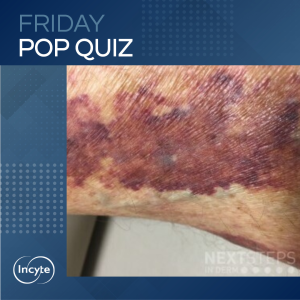
The correct answer is A. Age and photo damage.
Senile purpura is a common, benign condition characterized by the recurrent formation of purple ecchymoses (bruises) on the extensor surfaces of forearms following minor trauma.
Senile purpura affects over 10% of those aged over 50 years old and is associated with aging. It is equally common in males and females. Other risk factors include chronic sunlight exposure.
Thick vessel walls: With age and photodamage, the dermal tissues become thin and increase the fragility of blood vessels. The subsequent extravasation of blood into the surrounding dermis results in the development of dark purple ecchymoses. Persistent brown pigmentation following the resolution of the bruises results from the deposition of haemosiderin, a component of red blood cells.
Iron deficiency anemia: This is not a common cause of solar or actinic purpura.
Hereditary hemochromatosis: This is not a common cause of solar or actinic purpura.
References:
Tattersall RN, Seville R. Senile purpura. QJM. 1950:19 (2): 151-159.
Beauregard S, Gilchrest BA. A survey of skin problems and skin care regimens in the elderly. Arch Dermatol. 1987:123 (12), 1638. Pubmed PMID: 3688904.
Ratliff CR, Fletcher KR. Skin tears: a review of the evidence to support prevention and treatment. Ostomy Wound Manage. 2007:53 (3), 32-42. Pubmed PMID: 17395986.
Brought to you by our brand partner
